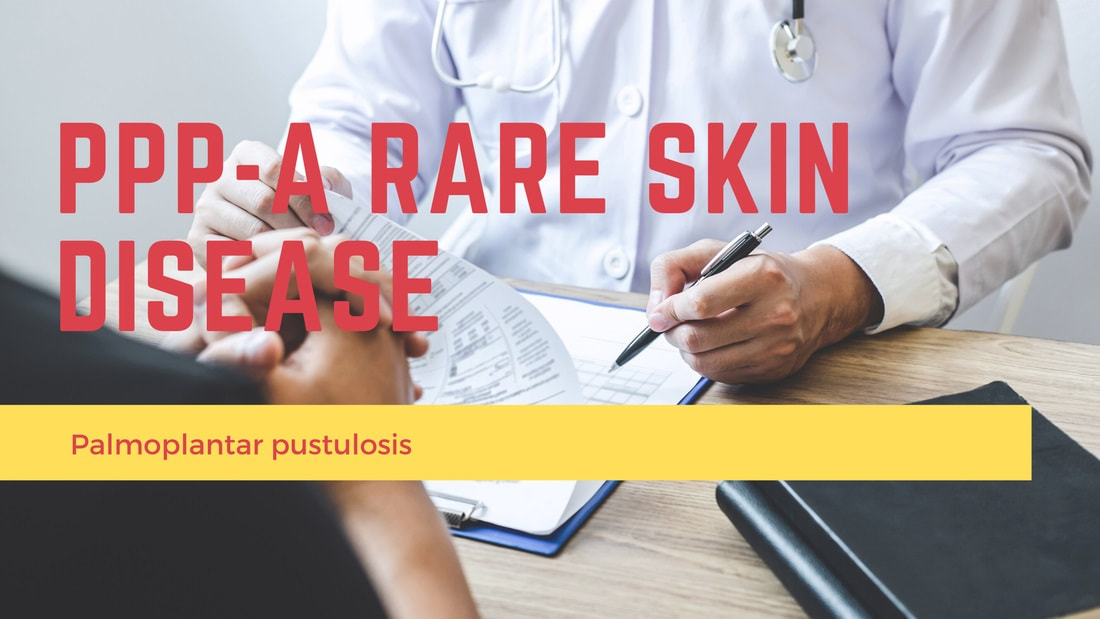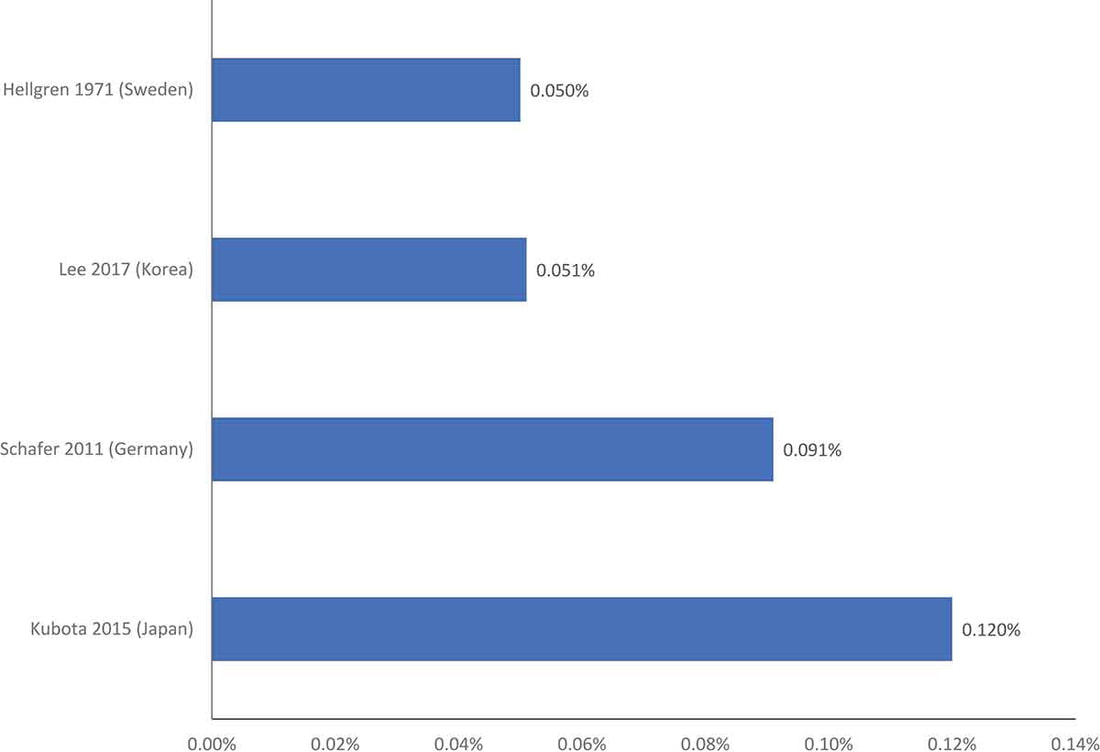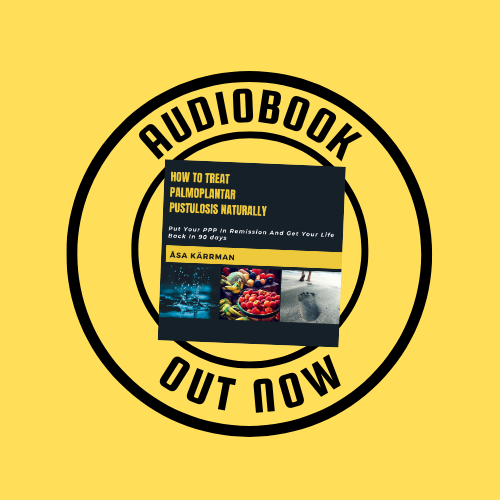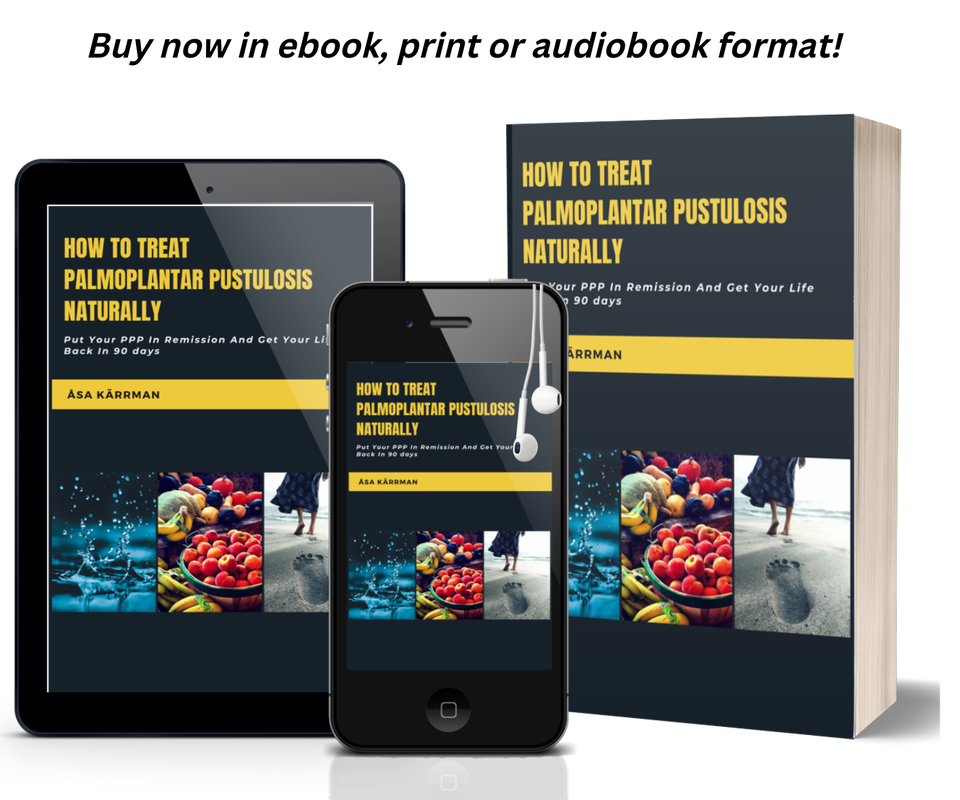|
Palmoplantar Pustulosis is a rare chronic skin disease and generally there are not many statistics on PPP out there. According to some researchers PPP is part of the psoriasis family, and to others it is not. The views differ as the genetic predispositions are not the same for both psoriasis and PPP. The crops of pustules may occur with psoriasis, or like in my case without any other form of psoriasis at all.
Different studies are showing a different prevalence rate when it comes to how common amongst the population Palmoplantar Pustulosis are, depending on which country the statistics has been pulled from. The Swedish dermatology department has an outpatient data register which found an incidence of PPP in relation to other skin diseases in 0.37 percent of patients. Patients with signs of psoriasis elsewhere on the body were excluded in this study. This gives a prevalence of PPP in Sweden of about 0.05%. Just like any other autoimmune disease the majority of the patients are women (75-82%) and the age at onset is usually between 40 and 60 years. The study is from 1971, so these numbers have most likely increased since then. (Enfors & Molin 1971, Hellgren & Mobacken 1971). In a more recent study from 2019 researchers pulled out data from the healthcare registries and insurance databases in the US, Denmark and Germany and got an estimate during a 1-year prevalence of 0.009%, 0.005% and 0.08% in each country.
USA 0.009% = 900 people per 100 000 population
Denmark 0.005% = 500 people per 100 000 population Sweden 0.005% = 500 people per 100 000 population Germany 0.08% = 8000 people per 100 000 population According to a Japanese study, Japan had a confirmed prevalence of 0.0012% PPP sufferers in the whole country during the years of 2010 and 2011. They found out that 148 887 people in Japan had PPP during that period out of a population of 128 million. 12 663 patients out of those 148 887 also had psoriasis. The study is really good as 95% of the whole population is included in it. In Japan they register every disease of a patient using a specific code. Japan - 0,0012 = 120 people / 100 000 population So the fact is Palmoplantar Pustulosis is not that common of a disease compared to other autoimmune diseases. The interesting data is to why the PPP prevalence is so much higher in Germany compared to the other countries above? I can’t find any information about this and I can’t find any information if Germany has a higher rate of other autoimmune diseases compared to Denmark, Sweden, US and Japan. Prevalence of PPP across studies. Autoimmune disease are increasing
Autoimmune diseases affect millions of people all around the world and It's one of the top ten causes of death in women under the age of 65. It's the second highest cause of chronic illness, and is the top cause of morbidity in women in the United States. Researchers estimate there’s around 80 different types of autoimmune diseases including lupus, Type 1 diabetes, Celiac, Multiple sclerosis, Crohn’s disease, rheumatoid arthritis, psoriasis and many more.
If you look at statistics over autoimmune diseases worldwide they are increasing. They estimate that 41 000 000 people in America have an autoimmune disease according to this study published in 2020, but it’s probably much higher now as the study only compared data between 1988 and 2012. The average percentage of autoimmune diseases in the western world is 5%. In Asia the rate is a bit lower. Until recently it was believed that genetics was the main factor contributing to autoimmune predisposition. But the rate at which autoimmune diseases are rising far exceeds the rate at which genes can pass them on. So the increase in autoimmune diseases over the past 20 to 30 years can't be explained down to only genetics as the genes don’t change that fast over generations. This means it must be something environmental as well. Studies are also starting to look into if diet and lifestyle has an impact on onset autoimmune disease. In the Western countries over the last hundred years our diet has changed profoundly as a result of us eating a high intake of calories derived from fried products, butter, sugar, gluten and processed food are being favoured over dietary regimens rich in fruits and vegetables. The poor quality of food has also resulted in a lack of intake of vitamins and minerals which is crucial for our immune system to operate most efficiently. In Asia and Southeast Asia, autoimmune disease was almost unheard of a couple of decades ago but with their financial and living conditions improving so are their change in diet habits which are becoming more westernised. People from developing nations are also developing the same rate of autoimmune disease as the rest of the western world. I write more about how diet at lifestyle changes can heal Palmoplantar Pustulosis or any other autoimmune disease in my book, do consider reading it if you are looking into healing PPP using a natural approach . Åsa Kärrman
8 Comments
Nanna
8/25/2020 01:09:58 pm
Hi. In your book it says avoid iron and calcium to combat biofilm, but you recommend taking chlorella and drinking green juices. Chlorella is rich in iron and often green juices are too. So should I or should I not limit iron?
Reply
Hi Nanna,
Reply
crystal
9/14/2020 10:12:44 am
I just received my copy of the book.. I pray that soon I may see the light at the end of the tunnel. Metal Toxicity led to my PPP.. My team of docs believes smoking is a factor with PPP because of the nickel. At least that's what they've concluded with my case in mind.
Reply
Hi Crystal,
Reply
Dusman
11/14/2021 02:44:37 pm
Hello,
Reply
Åsa Well-Healed
11/14/2021 07:17:17 pm
Hi Dusman,
Reply
Leave a Reply. |
Get my free booklet outlining the foods you can eat and which ones to avoid while healing from PPP . Enter your email address below and click subscribe.
1. Why is it so difficult to diagnose Palmoplantar Pustulosis? |
Disclaimer and privacy policy terms:
Read our GDPR privacy policy here
The information and advice published or made available through the www.well-healed.com web site is not intended to replace the services of a doctor nor does it constitute a doctor-patient relationship. Information on this web site is provided for informational and educational purposes only and is not a substitute for professional medical advice. You should not use the information on this web site for diagnosing or treating a medical or health condition. You should consult a physician in all matters relating to your health, and particularly in respect to any symptoms that may require diagnosis or medical attention. Any action on your part in response to the information provided in this web site is at the reader’s discretion. Readers should consult their own doctors or naturopaths concerning the information on this web site. www.well-healed.com makes no representations or warranties with respect to any information offered or provided on or through the www.well-healed.com web site regarding treatment, action, or application of medication or therapies. www.well-healed.com is not liable for any direct or indirect claim, loss or damage resulting from use of this web site and/or any web site(s) linked to/from it. Well Healed is a participant in the Amazon Services LLC Associates Program, an affiliate advertising program designed to provide a means for sites to earn advertising fees by advertising and linking to amazon.com.
Read our GDPR privacy policy here
The information and advice published or made available through the www.well-healed.com web site is not intended to replace the services of a doctor nor does it constitute a doctor-patient relationship. Information on this web site is provided for informational and educational purposes only and is not a substitute for professional medical advice. You should not use the information on this web site for diagnosing or treating a medical or health condition. You should consult a physician in all matters relating to your health, and particularly in respect to any symptoms that may require diagnosis or medical attention. Any action on your part in response to the information provided in this web site is at the reader’s discretion. Readers should consult their own doctors or naturopaths concerning the information on this web site. www.well-healed.com makes no representations or warranties with respect to any information offered or provided on or through the www.well-healed.com web site regarding treatment, action, or application of medication or therapies. www.well-healed.com is not liable for any direct or indirect claim, loss or damage resulting from use of this web site and/or any web site(s) linked to/from it. Well Healed is a participant in the Amazon Services LLC Associates Program, an affiliate advertising program designed to provide a means for sites to earn advertising fees by advertising and linking to amazon.com.







 RSS Feed
RSS Feed